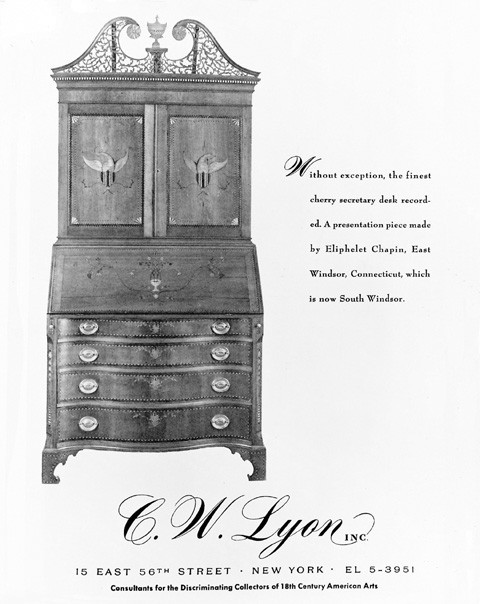
Desk-and-bookcase in an advertisement by C. W. Lyon, Inc., 1945. (Illustrated in Antiques 47, no. 5 [May 1945]: 249; photo, Winterthur Museum Library.) For a current view of the desk-and-bookcase, see fig. 32.
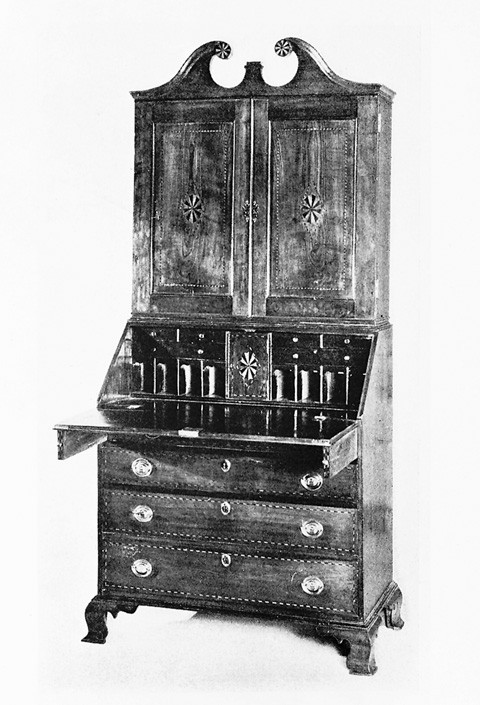
Desk-and-bookcase with a label of Webb and Scott, southeastern Massachusetts or northern Rhode Island, 1790–1805. (Illustrated in American Art Association, The Collection of the Late Philip Flayderman, New York, January 2–4, 1930, lot 431; photo, Winterthur Museum Library.)
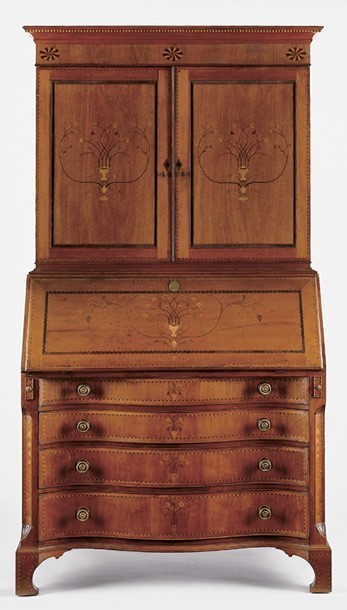
Desk-and-bookcase attributed to Nathan Lombard, southern Worcester County (possibly Sutton), Massachusetts, 1800–1805. Cherry, cherry veneer, mahogany banding, and light- and darkwood inlays with white pine. H. 80 1/2", W. 44", D. 18 3/4". (Courtesy, Milwaukee Art Museum, Layton Art Collection; photo, Gavin Ashworth.)

Detail of the initials “ET” scratched into the inlaid decoration on the door of the desk-and-bookcase illustrated in fig. 3. (Photo, Gavin Ashworth.)
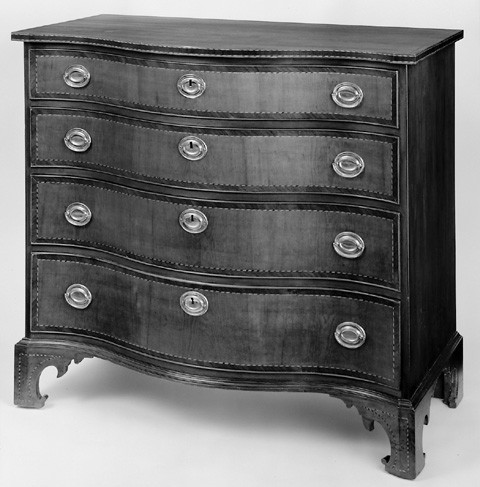
Chest of drawers by Nathan Lombard, southern Worcester County (possibly Sutton), Massachusetts, 1800. Cherry, cherry veneer, mahogany banding, and light- and darkwood inlays with white pine. H. 37 1/2", W. 41 3/8", D. 21 3/4". (Private collection; photo, Gavin Ashworth.) The brasses are replaced, and the beaded strip on the back edge of the top is missing.

Detail of the foot of the chest of drawers illustrated in fig. 5. (Photo, Gavin Ashworth.)
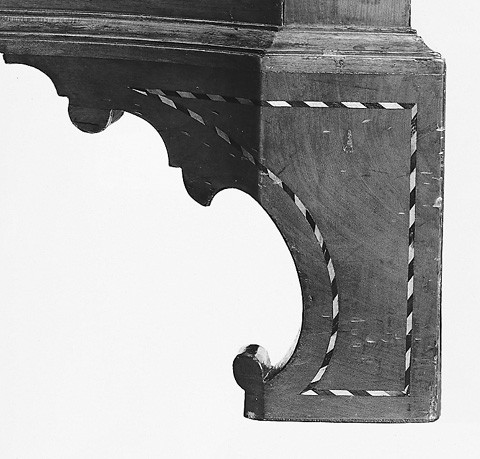
Detail of the foot of the desk-and-bookcase illustrated in figs. 1 and 32.

Detail of the inscription, “Made by Nathan Lombard Apl 20 1800/ Repaired by Enoch Pond March 21th 1837,” on the bottom of the chest of drawers illustrated in fig. 5. (Photo, Gavin Ashworth.)
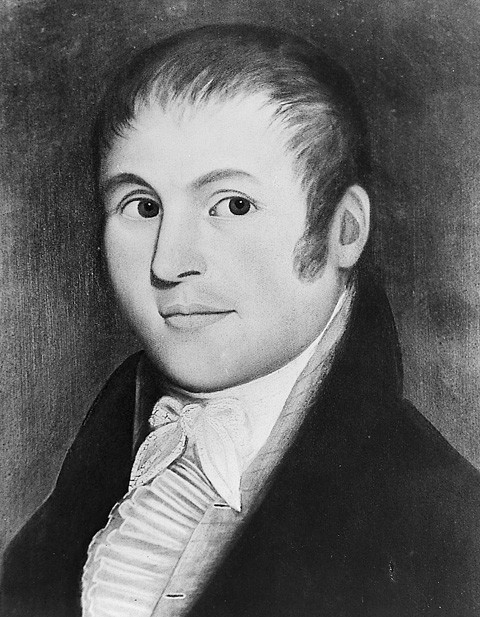
Portrait of Nathan Lombard attributed to Zedekiah Belknap, possibly Sutton, Massachusetts, 1802–1815. (Private collection; photo, Gavin Ashworth.) The current location of this portrait is unknown; this illustration was copied from a photograph of the portrait in the collection of the Sutton Historical Society.
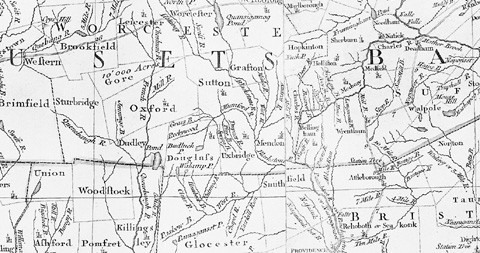
Detail of A Map of the Most Inhabited Part of New England, published by Tobias Conrad Lotter, Augsburg, 1776. (Private collection; photo, Winterthur Museum.)
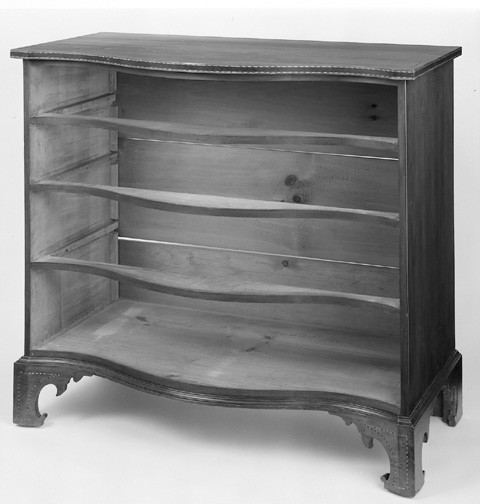
Detail of the interior of the chest of drawers illustrated in fig. 5. (Photo, Gavin Ashworth.)
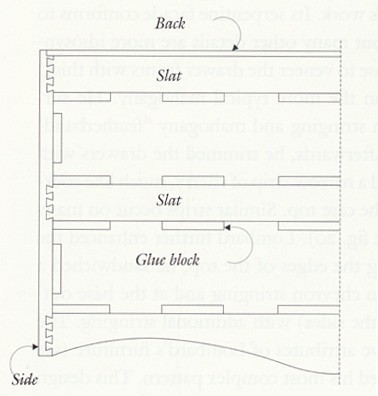
Drawing showing the three pine slats that form the sub-top of the chest of drawers illustrated in fig. 5. (Artwork, Wynne Patterson.)
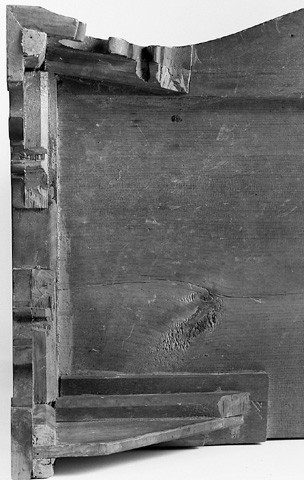
Detail of the bottom of the chest of drawers illustrated in fig. 5. (Photo, Gavin Ashworth.)

Detail of the rear foot of the chest of drawers illustrated in fig. 5. (Photo, Gavin Ashworth.)
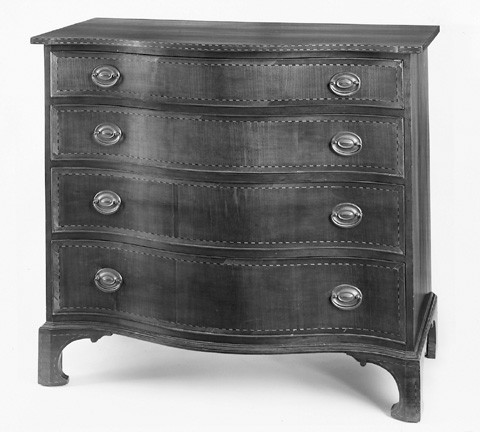
Chest of drawers attributed to Nathan Lombard, southern Worcester County (possibly Sutton), Massachusetts, 1800–1805. Cherry, cherry veneer, mahogany banding, and light-and darkwood inlays with white pine. H. 37", W. 41 7/8", D. 21 1/2". (Private collection; photo, Gavin Ashworth.)
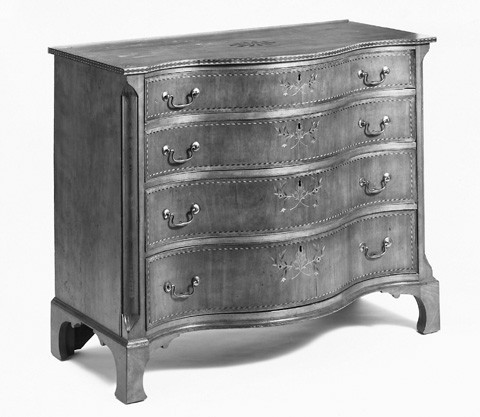
Chest of drawers attributed to Nathan Lombard, southern Worcester County (possibly Sutton), Massachusetts, 1800–1805. Cherry, cherry veneer, mahogany banding, and light- and darkwood inlays with white pine, butternut, and basswood. H. 37 1/8", W. 44 7/8", D. 21 1/2". (Private collection; photo, Winterthur Museum.) The feet are modern replacements.

Detail of the corner column on the chest of drawers illustrated in fig. 16.
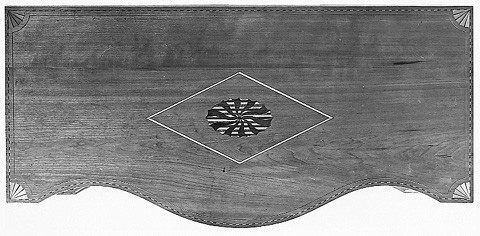
Detail of the top of the chest of drawers illustrated in fig. 16.
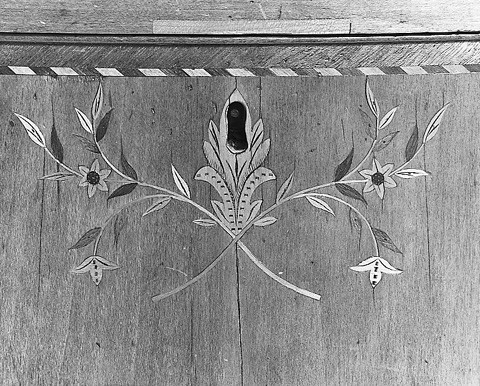
Detail of the decorative inlay surrounding the keyhole on the chest of drawers illustrated in fig. 16.
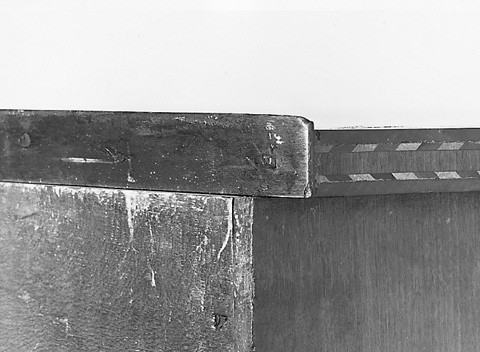
Detail of the applied strip along the upper back edge of the chest of drawers illustrated in fig. 16.
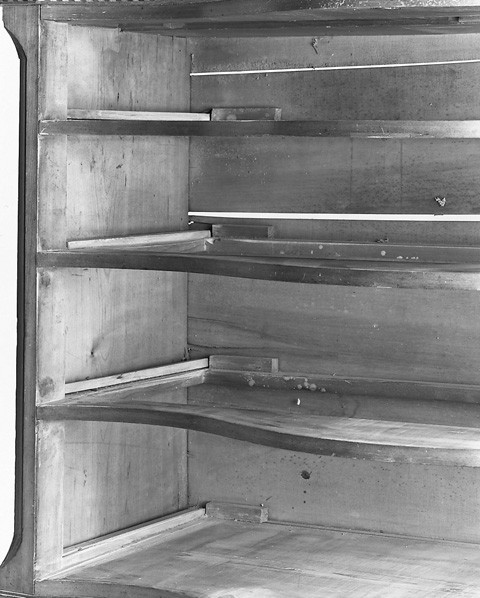
Detail of the interior of the chest of drawers illustrated in fig. 16.
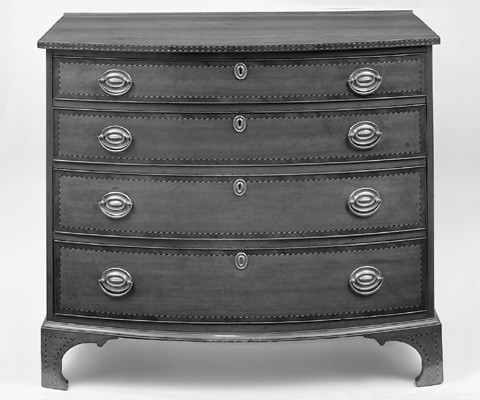
Chest of drawers attributed to Nathan Lombard, southern Worcester County (probably Sutton), Massachusetts, 1800–1810. Cherry, cherry veneer, mahogany banding, and light-and darkwood inlays with white pine. H. 33 7/8", W. 33 7/8", D. 20 3/4". (Private collection; photo, Gavin Ashworth.)
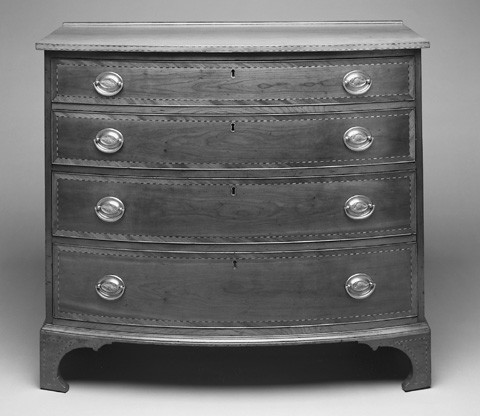
Chest of drawers attributed to Nathan Lombard, southern Worcester County (probably Sutton), Massachusetts, 1800–1810. Cherry, cherry veneer, mahogany banding, and light-and darkwood inlays with white pine. H. 35", W. 40 1/4", D. 22 1/2". (Private collection; photo, Thomas Jenkins.)

Chest of drawers attributed to Nathan Lombard, southern Worcester County (probably Sutton), Massachusetts, 1800–1810. Cherry and light- and darkwood inlays with white pine. H. 36", W. 43 5/8", D. 21". (Courtesy, Henry Ford Museum & Greenfield Village.)
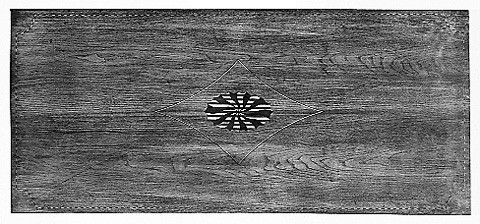
Detail of the top of the chest of drawers illustrated in fig. 24.
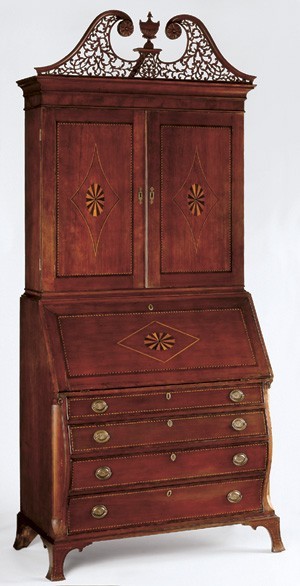
Desk-and-bookcase attributed to Nathan Lombard, southern Worcester County (probably Sutton), Massachusetts, 1800–1810. Cherry, mahogany and cedrella banding, and light- and darkwood inlays with white pine and yellow poplar. H. 102 1/16", W. 46 3/4", D. 32". (Private collection; photo, Gavin Ashworth.) The pediment is a modern replacement based on the one on the desk-and-bookcase shown in fig. 32.
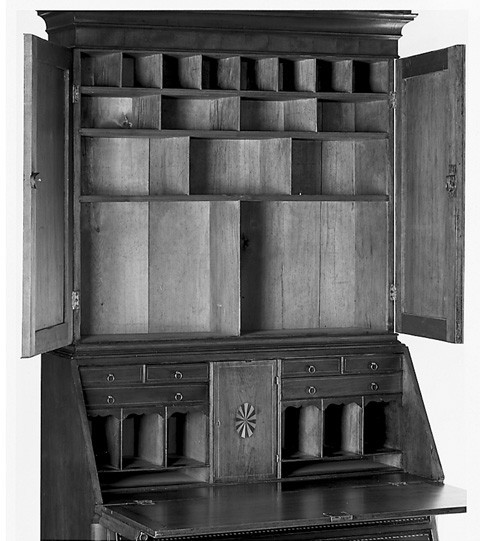
Detail of the interior of the desk-and-bookcase illustrated in fig. 26. (Photo, Gavin Ashworth.)

Detail of the inlaid decoration on the corner column of the chest of drawers illustrated in fig. 24.
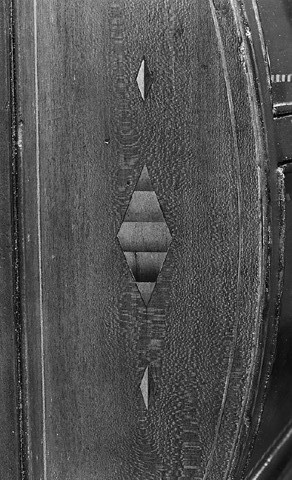
Detail of the inlaid decoration on the corner column of the desk-and-bookcase illustrated in fig. 26. (Photo, Gavin Ashworth.)
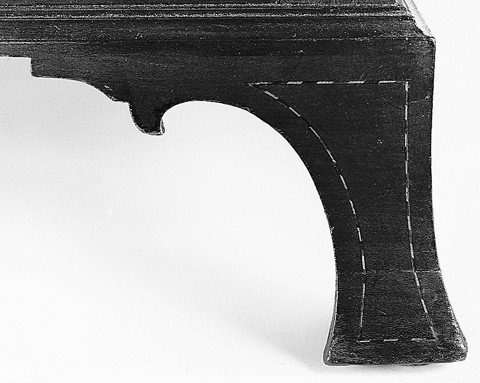
Detail of the foot of the desk-and-bookcase illustrated in fig. 26. (Photo, Gavin Ashworth.)
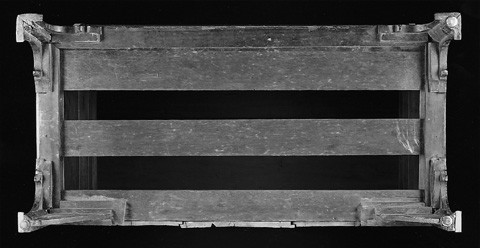
Detail of the bottom of the desk-and-bookcase illustrated in fig. 26. (Photo, Gavin Ashworth.)

Desk-and-bookcase attributed to Nathan Lombard, southern Worcester County (possibly Sutton), Massachusetts, 1800–1805. Cherry, cherry veneer, mahogany banding, and light- and darkwood inlays with white pine. H. 92 1/2", W. 41 1/4", D. 20 1/2". (Courtesy, Winterthur Museum.)
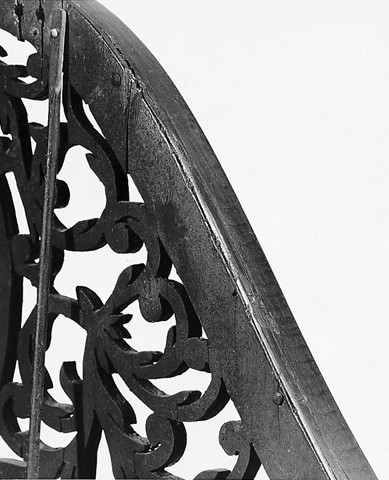
Detail of the cherry laminates that form the tympanum of the desk-and-bookcase illustrated in fig. 32.

Detail of the eagle inlay on the door of the desk-and-bookcase illustrated in fig. 32.

Detail of the corner column of the desk-and-bookcase illustrated in fig. 32.

Detail of the pins that anchor the upper and lower cases of the desk-and-bookcase illustrated in fig. 26. (Photo, Gavin Ashworth.)
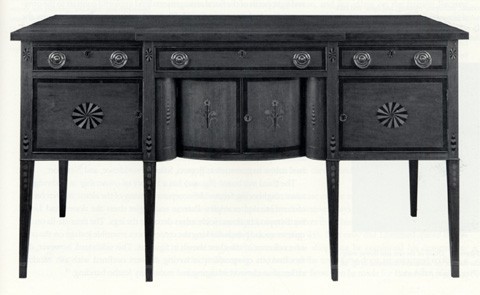
Sideboard attributed to Nathan Lombard, southern Worcester County (probably Sutton), Massachusetts, 1800–1810. Cherry, cherry veneer, mahogany banding, and light- and darkwood inlays with white pine. H. 40", W. 73 1/2", D. 28 1/4". (Private collection; photo, Gavin Ashworth.)
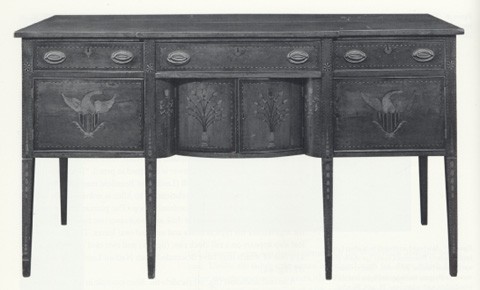
Sideboard attributed to Nathan Lombard, southern Worcester County (probably Sutton), Massachusetts, 1800–1810. Cherry, cherry veneer, mahogany banding, and light- and darkwood inlays with white pine. H. 40", W. 73 1/2", D. 28 1/4". (Private collection; photo, Gavin Ashworth.)
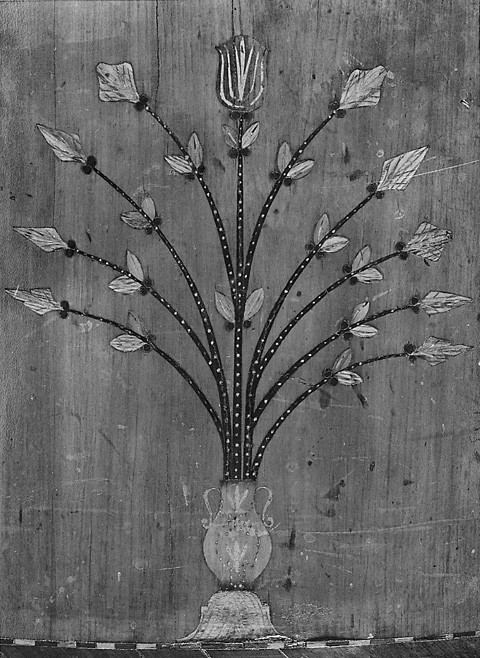
Detail of the urn and flower inlay on the door of the sideboard illustrated in fig. 38. (Photo, Gavin Ashworth.)
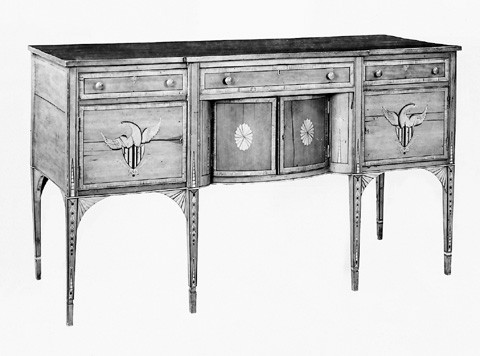
Sideboard possibly by Nathan Lombard, southern Worcester County (probably Sutton), Massachusetts, 1800–1810. Cherry, cherry veneer, ash banding, and light- and darkwood inlays with white pine. H. 39 1/4", W. 69 3/8", D. 27 1/4". (Courtesy, Henry Ford Museum & Greenfield Village.) The mahogany top is a replacement.
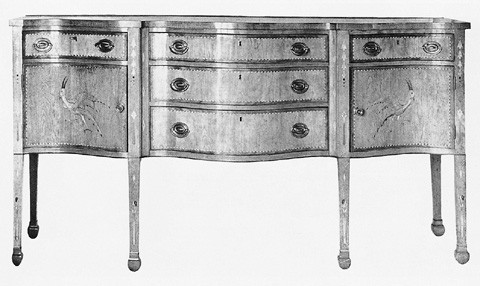
Sideboard attributed to Nathan Lombard, southern Worcester County (probably Sutton), Massachusetts, 1800–1810. Cherry, cherry veneer, mahogany banding, and light- and darkwood inlays with white pine. H. 39 1/2", W. 76", D. 30 1/2". (Illustrated in Homer Eaton Keyes, “Little Known Masterpieces: IV. A Heppelwhite [sic] Sideboard,”Antiques 1, no. 4 [April 1922]: 157; photo, Winterthur Museum Library.)

Tall clock case attributed to Nathan Lombard, southern Worcester County (probably Sutton), Massachusetts, 1800–1810. Cherry, cherry veneer, mahogany banding, and light-and darkwood inlays with white pine. H. 91", W. 21 1/4", D. 10 3/8". (Private collection; photo, Gavin Ashworth.) The feet and finials are modern replacements, and the gallery is damaged.
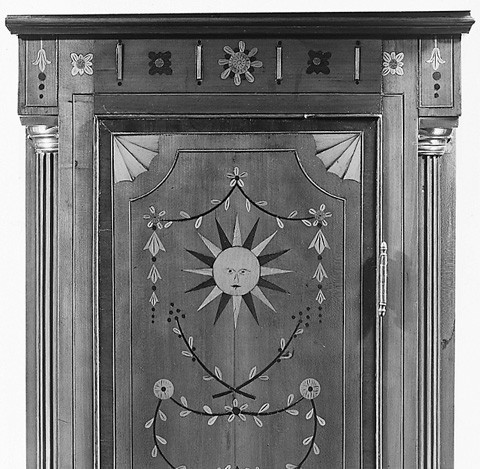
Detail of the door of the tall clock case illustrated in fig. 42. (Photo, Gavin Ashworth.)
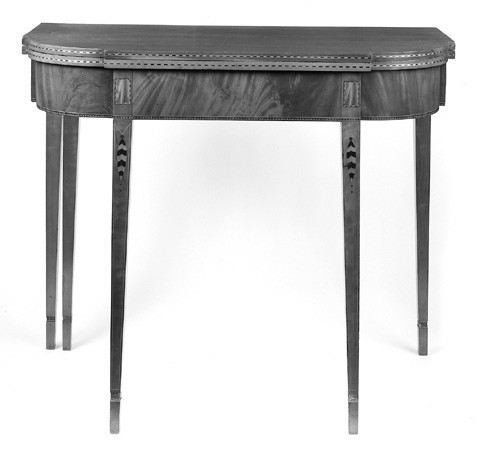
Card table attributed to Nathan Lombard, Sutton, Massachusetts, 1803–1810. Cherry, mahogany veneer, and light- and darkwood inlays with white pine. H. 29 1/2", W. 36", D. (closed) 17 3/4". (Private collection; photo, Gavin Ashworth.) The table belonged to Abijah Woodward and has his name in chalk on the underside of the top.
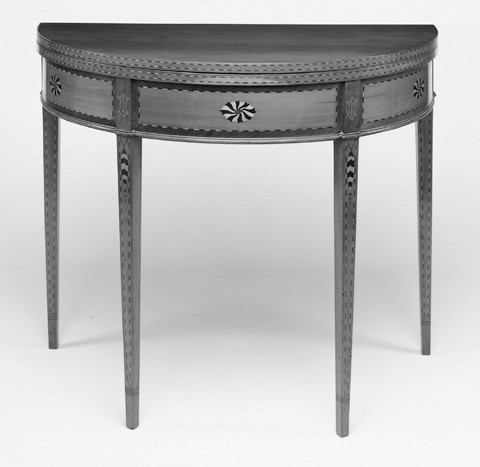
Card table attributed to Nathan Lombard, southern Worcester County (probably Sutton), Massachusetts, 1800–1810. Cherry, cherry veneer, mahogany banding, and light- and darkwood inlays with white pine. H. 29 7/8", W. 29 5/16", D. (closed) 19 3/8". (Private collection; photo, Thomas Jenkins.)
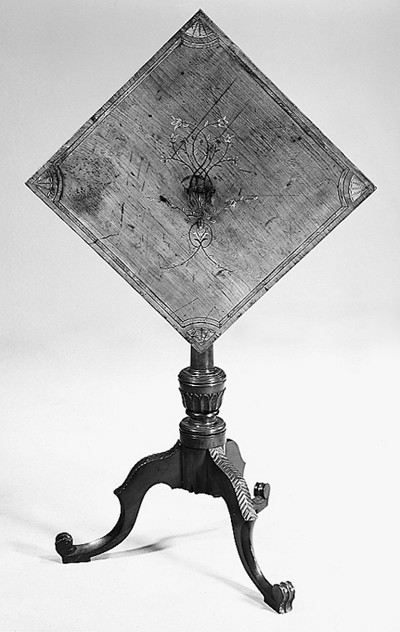
Candle stand attributed to Nathan Lombard, southern Worcester County (possibly Sutton), Massachusetts, 1801. Cherry, mahogany banding, and light- and darkwood inlays with white pine. H. 27 7/8", W. 17 5/8", D. 17 3/8". (Courtesy, Yale University Art Gallery, Mabel Brady Garvan Collection.)
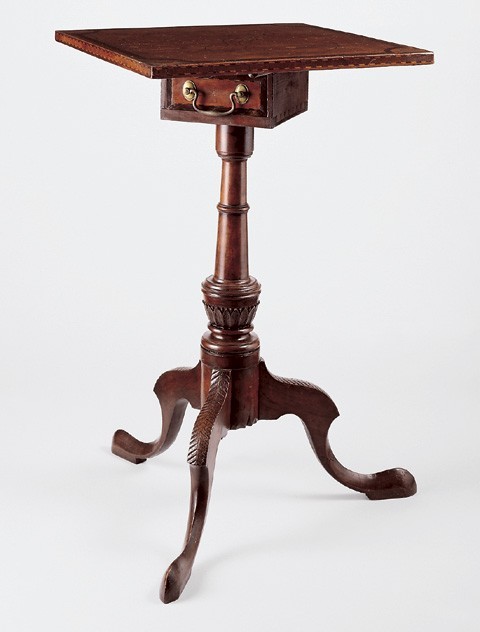
Candle stand attributed to Nathan Lombard, southern Worcester County (possibly Sutton), Massachusetts, 1800. Cherry, mahogany banding, and light- and darkwood inlays with white pine. H. 277/8", W. 17 3/8", D. 17 1/16". (Private collection; photo, Gavin Ashworth.)
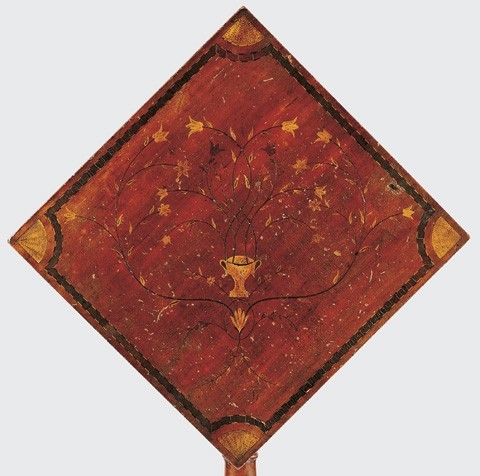
Detail of the top of the candle stand illustrated in fig. 47. (Photo, Gavin Ashworth.)
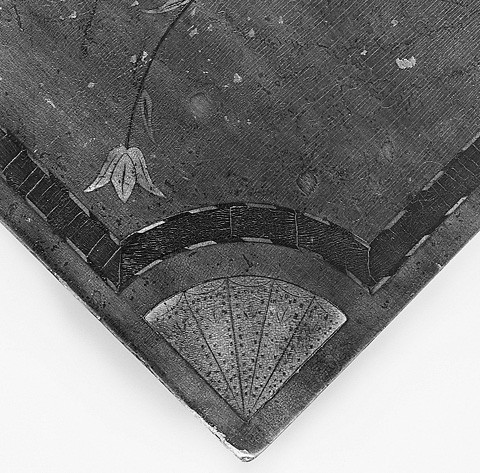
Detail of the quarter-fan inlay on the top of the candle stand illustrated in fig. 47. (Photo, Gavin Ashworth.)
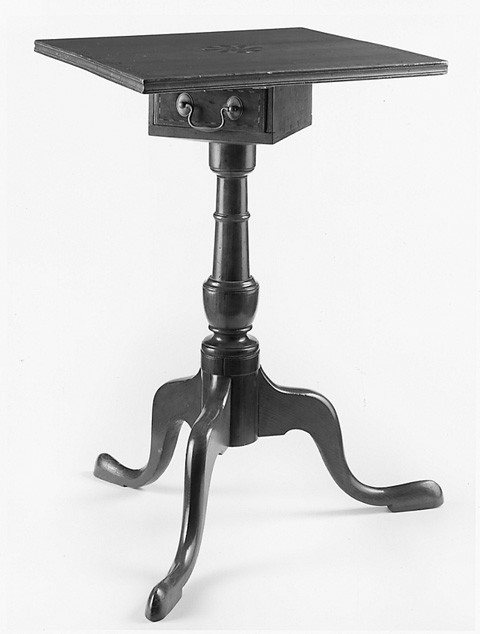
Candle stand attributed to Nathan Lombard, southern Worcester County (possibly Sutton), Massachusetts, 1800–1805. Cherry and light- and darkwood inlays with white pine. Dimensions not recorded. (Private collection; photo, Gavin Ashworth.)

View of the candle stand illustrated in fig. 50 with the top up. (Photo, Gavin Ashworth.)
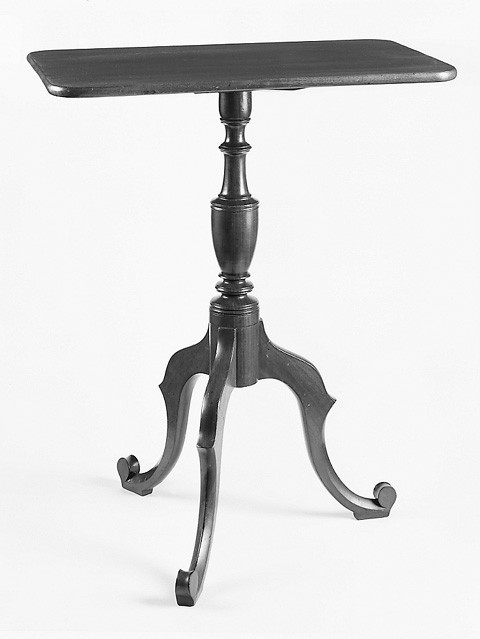
Stand attributed to Nathan Lombard, Sutton, Massachusetts, 1803–1810. Mahogany with cherry. H. 27 3/4", W. 15", D. 24". (Private collection; photo, Gavin Ashworth.)
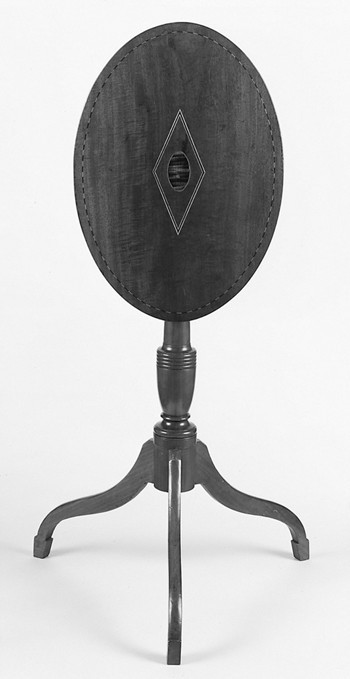
Stand attributed to Nathan Lombard, Sutton, Massachusetts, 1803–1810. Cherry, mahogany veneer, and light- and darkwood inlays. H. 27 3/4", W. 14", D. 19 15/16". (Private collection; photo, Gavin Ashworth.)
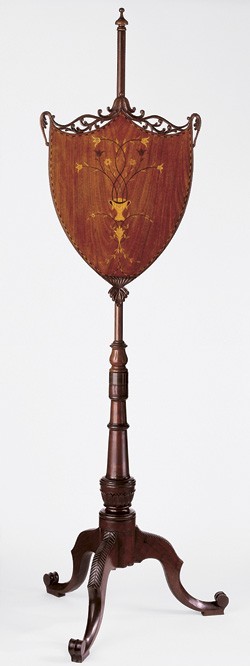
Firescreen attributed to Nathan Lombard, southern Worcester County (possibly Sutton), Massachusetts, 1800–1805. Cherry and light- and darkwood inlays with chestnut. H. 59 1/4". (Private collection; photo, Gavin Ashworth.)
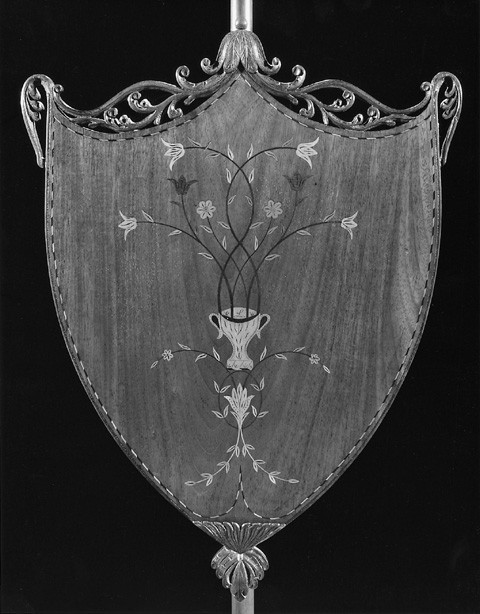
Detail of the shield of the firescreen illustrated in fig. 54. (Photo, Gavin Ashworth.)
In 1945, antique dealer Charles Woolsey Lyon described the desk-and-bookcase illustrated in figure 1 as “without exception, the finest cherry secretary desk recorded.” In this case such hyperbole was warranted. The intricate, pierced pediment, distinctive floral inlays, and flamboyant shield and eagle marquetry set the piece apart from contemporary New England work. The desk-and-bookcase attracted great interest, and within months the country’s leading collector, Henry Francis du Pont, had purchased it for his home at Winterthur. Charles Montgomery, the Winterthur Museum’s first director, selected it for the cover of his landmark catalogue, American Furniture, The Federal Period in the Henry Francis du Pont Winterthur Museum, and described the desk-and-bookcase as being “among the first rank of furniture in the Federal period.” Despite its prominence, the desk-and-bookcase has remained an enigma. Montgomery could not pinpoint its origin, suggesting either Connecticut or Rhode Island as possible places of manufacture. Recent research, however, has tied the Winterthur desk-and-bookcase to a group of nearly forty closely related objects, one of which bears the inscription of its maker, Nathan Lombard (1777–1847), of Sutton, Massachusetts. This article explores the characteristics of this group and chronicles the career of this little-known cabinetmaker.[1]
The route that led the authors to Lombard has been a meandering one, with many detours along the way. In his 1945 advertisement, Lyon associated the Winterthur desk-and-bookcase with the noted East Windsor, Connecticut, cabinetmaker Eliphalet Chapin (1741–1807). Lyon had purchased the piece from a Boston client who believed that Chapin had made it as a wedding present for his daughter. It reportedly descended through her family to a Miss Wheelwright of Commonwealth Avenue in Boston, where it was photographed before 1940. Though interesting, the story is spurious, for Chapin’s documented work bears little resemblance to the desk-and-bookcase either in design or construction. Montgomery alluded to a more promising connection when he compared the piece to a desk-and-bookcase bearing the label of Adrian Webb (1790–1840) and Charles Scott (1795–1851) of Providence, Rhode Island (fig. 2). Both objects were made of cherry and had similar desk interiors, comparable chevron stringing on the drawers, and bold, inlaid paterae. Unfortunately, Montgomery was unable to examine the labeled example. Sold at auction in 1930, its location remains unknown. Other furniture by Webb and Scott survives and sheds light on the careers of the artisans and their firm. They moved to Providence from neighboring Massachusetts communities during the second decade of the nineteenth century and worked together from 1816 to 1819. In all probability, the Webb and Scott label on the desk-and-bookcase documents a repair or secondhand sale rather than its manufacture.[2]
In 1962, Lyon advertised the flat-top desk-and-bookcase illustrated in figure 3. Although clearly from the same shop as the Winterthur example, it provided little new information regarding the place of origin or the maker of either piece. Lyon purchased it from Dr. Harlan Angier, who had recently found it in a house in Brookfield, twenty miles north of the Connecticut border. The initials “ET” incised into the urns on the doors provided a tantalizing clue to the identity of the maker or original owner, but the inscription could not be linked to a specific name (fig. 4); nevertheless, to many collectors, the desk-and-bookcase looked “Connecticut.” The dramatic impact of the decoration captured the eye of antiquarian Frederick Barbour, who purchased the desk-and-bookcase and shortly afterward donated it to the Connecticut Historical Society. The society exhibited the piece for nearly thirty-five years, until it was deaccessioned and sold at auction in 1996.[3]
New research had prompted the sale. In the December 1991 issue of Antiques, William Short compared the desk-and-bookcases at Winterthur and the Connecticut Historical Society to a striking group of furniture with histories of ownership in central Massachusetts. The group, which included a firescreen (see fig. 54) and two serpentine chests of drawers (see fig. 15), shared many details. The chests and desks had similar serpentine profiles, drawers faced with thick, vertical-grained cherry veneer, and feet outlined with chevron stringing. Additionally, most of the feet had a distinctive spur at the lower inside corner. The urn and flower inlay on the firescreen was strikingly similar to that on the fallboard of the Winterthur desk-and-bookcase, and both objects featured fretwork. Short suggested that all of the pieces may have originated in one shop and “hoped that further research, or perhaps the appearance of other pieces from the group . . . [would] someday identify the maker of this extraordinary furniture.” Although he could not attribute the group to a specific artisan, Short presented a compelling argument that they originated in rural Massachusetts, not in Connecticut or Rhode Island as many had believed.[4]
Short’s article not only precipitated the sale of the flat-top desk-and-bookcase but also placed it and the Winterthur example within a larger context. These distinctive desk-and-bookcases joined other case furniture, tables, and stands as the products of a single shop. A picture of a talented but idiosyncratic artisan with a penchant for inventive inlays began to emerge. Unknown to Short, the artisan’s identity lay in a chest of drawers offered by the New England Gallery in 1987 (fig. 5). Its serpentine facade, chevron stringing, cherry veneer, and mahogany banding tie it to one of the chests illustrated by Short (see fig. 15), and its feet virtually match those on the Winterthur desk-and-bookcase (figs. 6, 7). The bottom of the chest shown in figure 5 is inscribed “Made by Nathan Lombard Apl 20 1800” (fig. 8).[5]
Born in Brimfield, Massachusetts, in 1777, Lombard (fig. 9) was the fourth of ten children. His parents, Joseph and Mary, had married a decade earlier. Local records describe Joseph as a yeoman with a modest farming operation who seems to have been well respected within the community. He apprenticed Nathan’s older brother Ariel to Abner Allen of neighboring Sturbridge to learn the trade of tanning and may have apprenticed Nathan to a local cabinetmaker. Presumably, Nathan began to work on his own by 1798, when he reached the age of twenty-one. Four years later, he married Delight Allen in Sturbridge, but within the year they had moved to Sutton, sixteen miles to the east. Lombard chose his new home wisely. A well-traveled route linking Worcester and Providence passed through the town, and Boston was accessible by road just forty miles away (fig. 10). A prosperous farming community, nascent manufacturing center, and convenient crossroads, Sutton was in the midst of significant growth. By 1800 its population had reached 2,642 and was ranked second among Worcester County communities. Farming remained the primary occupation of residents, and, like many regional artisans, Lombard supplemented his income with agricultural activities. Cabinetmaking became increasingly important as population growth spurred local demand for household furnishings. The presence of turnpikes to Worcester, Providence, Boston, and westward toward Sturbridge and Brimfield facilitated the shipment of goods to a wider area. A highly skilled tradesman with strong commercial or family connections could find a sizable quantity of work. Lombard apparently had both, judging from the quality and design of his furniture and his extensive network of relatives. His wife’s family, the Allens, were particularly numerous and undoubtedly secured many commissions for Lombard. The firescreen, chest of drawers, and set of chairs illustrated and discussed in Short’s article belonged to Ezra Allen, a second cousin of Lombard’s wife. His home in Holland, Massachusetts, abutted Brimfield, the town where Lombard grew up.[6]
Such a widespread network of customers assured Lombard of business and probably kept him engaged in cabinetmaking for most of the year. To heighten productivity, he occasionally hired journeymen. In 1805, the Worcester National Aegis reported:
A Journeyman Cabinet-Maker. Wanted immediately a good workman that understands all branches of the business well enough to do Mahogany work of the best kind. Such a one will find constant employ and as good wages as they can get in Boston, by applying to NATHAN LUMBARD . . . . April 30, 1805. N. B. No other but a good work-man need apply.
William Benedict and Hiram Tracy’s History of the Town of Sutton, Massachusetts (1878) also noted that “Mr. Lombard[’s] . . . shop stood where Mr. Mitchell’s new house stands. He employed journeymen and apprentices. One of the latter, Clark Dalrimple, married Prudence Putnam, daughter of Aaron, and went to Providence, Rhode Island, where he became a wealthy broker.” [7]
Lombard’s oldest son, Alanson A. Lombard, assisted his father and later acquired his shop. An 1832 report of manufactures records the value of Alanson’s cabinetwares at $1,250, the largest total for any furniture maker in Sutton. In 1834 alone he sold merchant Jonathan Dudley twenty-three bedsteads for one dollar each. His trade also included more ornate work. According to town lore, he and his father built the pulpit for the First Congregational Church in about 1830.[8]
Nathan Lombard died on September 4, 1847. By all accounts, his career had been solid and successful. He attained sufficient wealth to purchase several properties in Sutton, maintain a pew in the First Church (termed the Center Meetinghouse in his will), and pay for portraits of both himself and his wife. He clearly had the respect of his peers, serving as town selectman on numerous occasions during the 1810s and 1820s. His tombstone is modest and reflects the middle-class standing that Lombard had secured for his family. Although both his house and cabinet shop are mentioned in his will, no inventory was taken of Lombard’s shop goods, lumber, tools, or personal possessions.[9]
Additional evidence of Lombard’s trade lies in the signed chest of drawers and thirty-five other pieces associated with him. All fall within the early neoclassical style and most date from the first decade of the nineteenth century, when Lombard was still in his twenties or early thirties. His designs reveal the influence of English sources such as George Hepplewhite’s The Cabinet-Maker and Upholsterer’s Guide (1st ed., 1788), as well as traditional rococo forms. Collectively, this furniture suggests that Lombard was a clever and imaginative artisan who produced useful and often flamboyant pieces for a prosperous rural clientele. The contrasting woods and inlaid birds, eagles, flowers, and urns that adorn much of his work undoubtedly appealed to his customers, judging from the number of surviving examples.
The furniture associated with Lombard includes six desk-and-bookcases, thirteen chests of drawers, seven sideboards, two card tables, five stands, a clock, a pembroke table, and a firescreen. All are related in design, ornament, or construction. In addition, several objects have historical connections to Lombard: the signed chest (fig. 5); a chest of drawers (fig. 15), a sideboard (fig. 37), and a firescreen (fig. 54) owned in the nineteenth century by Ezra Allen of Holland, Massachusetts; and a card table (fig. 45) and two stands (figs. 52, 53) that descended with portraits of Nathan and Delight Lombard (fig. 9). The latter items belonged to Abijah Woodward (1811–1895) of Sutton, who married Lombard’s daughter, Julia Ann, in 1837. They were later passed to descendants living in California and Massachusetts.
The signed chest of drawers (fig. 5) offers an appropriate starting point for the study of Nathan Lombard’s work. Its serpentine facade conforms to popular New England patterns, but many other details are more idiosyncratic. For example, Lombard chose to veneer the drawer fronts with thick, vertical-grained cherry rather than the more typical mahogany. He surrounded the veneer with chevron stringing and mahogany “featherbanding” (banding cut at an angle). Afterwards, he trimmed the drawers with cherry cockbeading. He also nailed a narrow strip of cherry, much like cockbeading, along the back edge of the case top. Similar strips occur on many examples of Lombard’s work (see fig. 20). Lombard further enhanced the chest with decorative inlay. Along the edges of the top, he sandwiched a broad band of mahogany between chevron stringing and at the base outlined the front brackets (but not the sides) with additional stringing. The feet are one of the most distinctive attributes of Lombard’s furniture (see fig. 6). On the signed chest, he used his most complex pattern. This design features a sharp spur on the lower inside edge and combines details commonly found on the feet of Boston rococo case pieces—cusp and bead shaping—and early neoclassical chests—inner C-scroll shaping. Lombard sometimes simplified this design by eliminating the cusp and occasionally the spur (see fig. 15).[10]
The construction of the case and feet follows a standard Massachusetts formula (fig. 11). The frame consists of solid cherry sides dovetailed to a pine bottom and sub-top. For the latter, Lombard chose three pine slats rather than a single board and dovetailed them to the case about four inches apart (fig. 12). He used screws and small glue blocks to attach the slats to the finished cherry top. Occasionally, Lombard varied the arrangement by inserting two broad slats rather than three narrower ones. The drawers of the signed chest have shallow dividers and supports that are glued and nailed into dadoes in the case sides. At the back of the case, he glued pine stops to the sides to prevent the drawers from pushing out the backboards. He planed the base moldings on relatively wide cherry boards, which he glued and nailed to the underside of the frame (fig. 13). These cove-molded boards are mitered at the front corners, as are the foot facings. The front facings are backed with vertical stumps flanked by horizontal blocks. At the back of the case, large triangular supports, reinforced with vertical and horizontal blocks, butt against the bracket feet (fig. 14). Each rear unit—consisting of foot facing, triangular support, and blocks—is glued to the base molding and a pine board of matching thickness.
Lombard built his drawers in a manner typical of his time and place. Dovetails of average quality bind the corners. The sides, back, and bottom are solid pine, and the veneered front is glued to a horizontally laminated core formed of one-inch-thick pine strips. Each drawer bottom is made of a single board set into grooves in the front and sides and nailed to the back with four cut nails. A series of small, widely spaced glue blocks reinforces the joint along the sides and front. Remarkably, all of the original glue blocks remain. In design, construction, and condition, this chest is the rosetta stone of Lombard’s work.
Five serpentine chests are closely related to the signed example. The best documented one (fig. 15) belonged to Ezra Allen (1773–1866) and presumably stood in a chamber of the farmhouse built by his father in the 1770s. The chest may date to 1802, the year of Ezra’s marriage to Mary Needham. It differs from the signed example in only one significant detail—the shape of the foot. This simpler design matches the feet of the desk-and-bookcase illustrated in figure 3. Another chest in a private collection has identically shaped feet and features lightwood banding, possibly of butternut rather than mahogany. A third chest sold at auction in 1987 omits the banding altogether. Instead, vertical-grained cherry veneer faces the entire drawer front, and chevron stringing is set into the veneer. This chest displays other economies as well. The edges of the top have a single line of chevron stringing rather than the customary two, and the feet lack any chevron stringing. Even in this basic model, however, the essential characteristics of Lombard’s work are clearly visible.[11]
The final two chests (fig. 16) are the most ambitious of the group. Rather than having squared corners, these chests are fitted with concave columns ornamented with inlay and capped with carved leaves. On the plainer example, a meandering vine surrounded by chevron stringing extends up the column. The other chest displays a more complex arrangement, with husk and dot inlay at the top, an inverted icicle at the bottom, and leaves at the center (fig. 17). The base and capital of each column are scooped to form pointed arches and carved in low relief with stylized leaves. The corner treatment on both chests defies popular tradition; rather than use conventional, convex quarter-columns, Lombard reversed the curve and added inlay. His inventiveness extended to other areas as well. On the top, an inlaid diamond frames a swirling paterae (fig. 18), whereas on each drawer a central leaf resting on crossed sprigs surrounds the keyhole (fig. 19). The latter detail is further enhanced with multicolored inlays and shallow chip cuts filled with a colored wax or resin. Similar features appear on Lombard’s grandest items—the desk-and-bookcases shown in figures 3 and 32. The presence of these inlay details and the convex corners on the chest clearly place it among his finest works. The chest retains many original features, including the brass hardware and applied bead along the back edge of the top, one of Lombard’s signature traits (fig. 20).[12]
The construction of the chests with concave columns varies in one noticeable detail from plainer versions attributed to Lombard. On the signed chest (fig. 5), the drawers run on narrow supports glued and nailed into dadoes in the case sides. The addition of the concave columns required much broader drawer supports. To provide adequate reinforcement, Lombard created a frame for the drawer by tenoning the supports into the drawer divider and into a rail at the back of the case (fig. 21). The frame is secured to the case at two points: The dividers are tenoned into stiles along the inner edge of the columns, and the supports are glued into dadoes in the case sides. Lombard employed this technique on every case piece with convex columns. The technique was successful, for the frames remain securely in place nearly two centuries after he installed them.
Two other types of chests can be attributed to Lombard. For the first, he modified a common federal form—the bowfront—by grafting the case onto straight bracket feet instead of onto the usual French feet. On the chest shown in figure 22, Lombard applied his characteristic chevron stringing to the top, drawers, and feet and placed a narrow beaded strip along the back edge of the top. With one exception, his construction methods match those of the signed chest; for bowfront chests Lombard chose horizontal-grained veneer for the drawer fronts, and on serpentine examples he used vertical-grained veneer. The four known bowfronts by Lombard conform far more closely in design than do his serpentines. Other than size, the two examples illustrated here (figs. 22, 23) are virtually identical. Apparently, he perfected a single model and found sufficient demand to repeat it for a number of clients.[13]
His last type of chest falls into a far more unusual category. On three chests (and a desk-and-bookcase) he employed a swelled facade (fig. 24). This distinctive shape has traditionally been linked to cabinetmaker George Stedman of Norwich, Vermont, on the basis of a signed example at the Winterthur Museum. Stedman began working on his own in 1816 and made the signed chest soon afterwards. Lombard’s swellfronts, however, were built much earlier, probably about 1800. On the swellfront example shown in figure 24, a complex swirling paterae in the top matches one on Lombard’s most ornate serpentine chest (figs. 25, 18). The distinctive concave columns with lamb’s tongue caps have corresponding details on the serpentine chests (see fig. 17) and the desk-and-bookcases illustrated in figures 3 and 32. Chevron stringing edges the top and outlines the drawers. Here, however, the stringing arcs in a quarter circle at the corners of the drawer, a favorite motif of neoclassical furniture makers but one rarely employed by Lombard. On the two related swellfront chests, Lombard used his more typical formula of chevron stringing framed by bands of mahogany. The case construction of the swellfront chests echoes that of his serpentine models. The methods for fastening the top and installing the framed drawer support system repeat similar treatments on Lombard’s signed chest (see fig. 12) and his most ambitious serpentine example (see fig. 21). Although the feet of the chest shown in figure 24 are replaced, the original support blocking remains intact. The pattern of the blocking conforms to that of the other chests, reinforcing the link between these unusual swelled chests and the rest of Lombard’s case furniture.[14]
The swellfront desk-and-bookcase illustrated in figure 26 is without question Lombard’s most commanding case piece. Although the scroll moldings and tympanum are replacements, the lower section of the removable pediment has a slot to receive a tympanum like that on the Winterthur desk-and-bookcase (fig. 32). This slot and evidence of braces guided the restoration. The design of the swellfront desk-and-bookcase has parallels in other desk-and-bookcases and chests attributed to Lombard. The paterae within diamonds on the fallboard and bookcase doors relate to similar features on the tops of several chests. In addition, the presence of chevron stringing and a single band of feathered mahogany on the doors and fallboard echoes the treatment of drawer fronts on the chests. The desk-and-bookcase interiors (fig. 27) are similar to those of the other examples (see figs. 3, 32), and the concave columns at the corners match those on the two swelled chests. The decorative motifs differ, however. On the chests, vertical strands of light and dark stringing intersect a floral sprig at the center of the column (fig. 28). On the swellfront desk-and-bookcase, the decoration is limited to a border of lightwood stringing and a central diamond flanked by smaller ones (fig. 29).[15]
Given the immense weight of the secretary, the base molding and feet are surprisingly diminutive (fig. 30). The molding is the standard cove profile seen on virtually all of Lombard’s work. The foot, however, differs from others in its restrained outline and flaring outer edge. Presumably Lombard sought to incorporate the sweep of the French bracket foot within his established vocabulary of traditional straight brackets.
Both the swellfront chests and desk-and-bookcase differ in one distinctive detail from Lombard’s other work. Like his counterparts throughout New England, Lombard typically used a solid bottom for his cases. Often made of one or two broad pine boards, the bottom is usually dovetailed to the case sides. On his swelled cases, he fabricated the bottom much like the sub-tops on his chests. Three slats, each set about four inches apart, are dovetailed to the bottom edge of the case sides (fig. 31). It is a peculiar arrangement rarely seen in early neoclassical furniture but more common on case furniture from the 1820s and 1830s.
Although slightly smaller than the swellfront example, the desk-and-bookcase at Winterthur is Lombard’s most impressive achievement (fig. 32). It is his only major case piece retaining its original pierced tympanum and central urn finial. Both are affixed to the pediment, which is comprised of a dovetailed frame that slips down over the outer edge of the bookcase top. Just one-quarter-inch in thickness, the tympanum consists of two laminations of cross-grained cherry veneer (fig. 33). This fragile component fits into a slot in the pediment and is backed by a series of support blocks at the base. The urn follows a standard neoclassical formula, but the carving is shallow and stylized. At the top of the urn, a husk and dot substitute for the more common flame.
Dramatic inlays on the doors of the desk-and-bookcase elevate it above its counterparts. The patriotic emblem of the eagle and shield command immediate attention (fig. 34). In this case, Lombard borrowed a motif that often appears in urban inlays in smaller form—for example, as a center tablet on Boston and Newport card tables. Lombard’s version is bold and individualistic. The shield is fashioned of vertical strips much like those used for the paterae of his best serpentine chests (see fig. 18). The sprigs below the shield are reminiscent of details on the fallboard and doors of the desk-and-bookcase shown in figure 3. Lombard’s skill is evident in the narrowing of the stem of the sprig as it extends to the tip. His eagles are carefully rendered, yet not complex. They are made of only three pieces: Two form the wings, and one serves as the body. Feathers are suggested by incised lines, and the illusion of depth results from shading with hot sand. The remaining inlays echo details on other case furniture attributed to Lombard. The urn and vine motif on the fallboard relates to that on the desk-and-bookcase illustrated in figure 3, and the escutcheon inlays on the drawers are more ambitious versions of those on his chests of drawers (see fig. 19). Lombard did, however, alter one design element on the Winterthur desk-and-bookcase. Unlike the other case pieces associated with his shop, which have either straight or concave corners, the Winterthur example has canted corners. The cants are embellished with a standard array of inlays, however. These include husks and dots at the top and an inverted icicle at the bottom (fig. 35).[16]
Four other desk-and-bookcases—the one shown in figure 3 and three plainer variants sold at auction—constitute the remaining examples of this stately form. As a group, they illustrate several consistent traits in addition to those already mentioned. All have steeply angled fallboards and waist moldings attached to the upper case, a feature more typical of Rhode Island furniture than that made in Massachusetts. The bookcases of the serpentine examples shown in figures 3 and 32 are anchored with two pins that extend up from the top of the desks and engage holes in the bottom of the upper case. On the swellfront example, the arrangement is reversed; pins in the bookcase slip into holes in the desk (fig. 36). Lombard used two pins that extend from the top of the desk section into holes in the bottom board of the bookcase. On the serpentine desk-and-bookcases, there is an awkward transition between the curved facade and straight fallboard.[17]
Lombard’s shop produced at least two other case forms—sideboards and clock cases. The sideboards display an eye-catching array of bold inlays. The exact combination of details varies on each example yet many distinctive motifs occur with sufficient regularity to warrant an attribution to Lombard. Three sideboards are most similar in form and decoration. All have rectangular cases that project slightly in the middle, bowed center doors flanked by convex panels, outer doors that are rectangular rather than square, and drawers and doors with chevron stringing and featherbanding. Pictorial inlays adorn the doors, and differing arrangements of paterae, icicles, and husks decorate the legs. The best-documented sideboard (fig. 37) belonged to Delight Lombard’s cousin Ezra Allen. Allen may have been the second owner. The upper left drawer is inscribed in pencil, “Daniel Lis[t or d]el Brimfield.” A Daniel Laisdell (Lasdell) of Brimfield married Betsy Lilley in 1801. Although Laisdell’s relationship to Allen is unknown, the sideboard is clearly a product of Lombard’s shop. The paterae on the outer doors compare with those on his desk-and-bookcases (see figs. 26, 27), and the legs feature his typical husks and unusual oval leaves. This distinctive leaf also appears on a tall clock case (fig. 42) and two card tables (see fig. 45), one of which may have descended from Nathan Lombard’s daughter (fig. 44).[18]
A second sideboard (fig. 38) parallels the Allen example in size and shape but displays more flamboyant inlays. Eagles resembling those on the Winterthur desk-and-bookcase (fig. 32) embellish the outer doors, two-handled urns with flowers decorate each inner door (fig. 39), and smaller floral bouquets grace the narrow quarter-round panels on either side. The dark stems and light petals of the floral arrangements lend a colorful contrast to the ornament. On the stems, punchwork filled with white pigment accentuates the contrast. Similar punchwork also occurs on the dark, sawtooth inlays on the feet. The construction of the sideboard relates to that of the Allen example. The sides and back are joined to the legs; the two-part cherry top is attached to the frame with glue blocks; and full dustboards separate the tier of drawers from the doors. The doors are made in two ways. The outer ones have horizontal cherry veneer on a cherry core, whereas the inner ones have vertical cherry veneer on a laminated white pine core. The case bottom consists of two pine boards beneath each section. These boards are secured with nails driven up into the partitions and through the back boards into the rear edge of the bottom. Lombard’s construction is adequate but not exceptional. It lacks the precision characteristic of the best neoclassical work from New England urban centers such as Boston, Salem, Providence, and Newport.
The third sideboard (fig. 40) has a history of ownership in Uxbridge, a town neighboring Sutton. It incorporates many of the elements seen on the aforementioned examples. Paterae and eagles dress the doors, and Lombard’s typical husk and icicle inlays decorate the legs. The fleur-de-lis on the quarter-round panels flanking the center doors resemble leafage on the concave columns of the chest shown in figure 16. This sideboard, however, differs from its counterparts in having drawers outlined with ash banding rather than chevron stringing and mahogany featherbanding.[19]
Three other sideboards share details with the preceding ones. Each has large eagle and shield inlays on the doors, ash banding on the drawers, and various versions of icicle, paterae, and fan inlays on the frames. Because these sideboards have not been examined, they are only offered as possible products of Lombard’s shop. A fourth sideboard is the most puzzling but, in many respects the most exciting example of the form (fig. 41). Pictured in a column titled “Little Known Masterpieces” in the April 1922 issue of Antiques, it has a beaded strip attached to the back and serpentine drawers with vertical-grained cherry veneer surrounded by chevron stringing and mahogany featherbanding, like other furniture attributed to Lombard. Although the husk and dot inlay and floral motifs on the sideboard relate to similar treatments on other case pieces, the fanciful herons on the doors are without parallel in nineteenth-century American furniture. More rococo than neoclassical, the birds are unique expressions of the chinoiserie taste in inlay. Lombard may have borrowed the design from imported British looking glasses, many of which have carved and gilded birds attached to their crests.[20]
Although only one tall clock case can be attributed to Lombard, it serves as a veritable sampler of his decorative inlays (fig. 42). The inlaid sun on the door does not occur on other pieces from his shop, but it is a common motif on neoclassical clock cases (fig. 43). Not only did Lombard quote details found on other forms from his shop, but he combined his designs creatively. The sprigs and husks at the top of the door are arranged to form a classical shield reminiscent of the firescreen he made for Ezra Allen (figs. 43, 54). The inlays on the clock case are also fabricated like those on other furniture by Lombard. His husks, for example, are cut from individual pieces, and the segments are articulated with shallow gouge cuts filled with a dark-colored wax or resin. The selection of woods for individual components is also consistent with his work.
Lombard’s tables and stands match his case furniture in inventive details and striking decoration. Two cherry card tables with histories of ownership in central Massachusetts bear clear marks of his manufacture. The first (fig. 44) belonged to Abijah Woodward (1811–1895) of Sutton. Woodward, who married Lombard’s daughter, may have inherited the table from his father-in-law or a member of his own family. The square frame with ovolo corners—often termed D-shaped today—adheres to a standard neoclassical pattern. Lombard probably bought the stylish urban inlays that edge the rails and outline the mahogany panel at the top of the legs; however, the pointed oval leaf on each leg and the light and dark stringing on the edge of the top appear to be products of his shop. Furthermore, the combination of solid cherry legs and top with mahogany veneered rails is in keeping with his use of mixed woods on chests. The presence of five legs (four fixed and one hinged) is more typical of Connecticut examples than those from Massachusetts.
The circular card table illustrated in figure 45 reportedly descended in a Brimfield family. It too has the light and dark oval leaf seen on the legs of the previous table. The decoration on the rails echoes that on Lombard’s drawers; cherry veneer is framed with chevron stringing and featherbanded mahogany. The stylized motif set between each panel of the rails resembles narrower versions at the center of the columns on his most ornate chests (see fig. 17). A cherry pembroke table illustrated in American Antiques from Israel Sack Collection relates to other Lombard furniture in its extensive use of chevron stringing on the tapered legs, drawer front, edges of the oval top, and even as a border on the top and leaves. Like several Lombard items, icicle inlay ornaments the top of the legs.[21]
Candle stands attributed to Lombard include both simple and ornate forms. Three closely related examples rank among his greatest achievements. Combining creative design, proficient carving, and imaginative inlays, they represent the best of rural craftsmanship. On the most ambitious (fig. 46), bold cabriole legs with stylized knee carving and scroll feet are joined to a turned pillar with carved leafage. The top of the pillar is tenoned into a dovetailed box fitted with a single drawer. The box in turn is pinned to cleats screwed to the underside of the top. Vibrant urn and floral inlay fills the center of the top, fan inlays grace the corners, and a band of mahogany borders the surface. Though lacking an extensive history, the stand is inscribed “E H / 1801” in the center of the inlaid urn on the top. The second example (fig. 47) differs from the first in only two noticeable details. The feet follow a more typical pattern, and the floral inlay on the top is more extensive (fig. 48). It too bears an incised date in the urn, in this case “1800.” In addition, the corners of the top have inlaid quarter-fans with punchwork filled with a colored resin or wax (fig. 49). This technique closely resembles that used on many Lombard pieces (see fig. 19). The third candle stand (fig. 50) is the plainest of the three. It has a simpler leg and pillar design, and the top is decorated with a swirling paterae (fig. 51) rather than urn and floral inlay. Collectively, these stands illustrate the range of options available within the form.[22]
Lombard also made less elaborate, tilt-top stands without drawers. Two descended from his daughter Julia Ann and son-in-law Abijah Woodward. For the first (fig. 52), Lombard modified the standard New England pattern dramatically. He combined a large rectangular top, shortened pillar, and steeply curved cabriole legs with pronounced knees and scroll feet akin to those on his most elaborate candle stand (fig. 46). Surprisingly, he fabricated these parts from mahogany, one of the few times he used the wood extensively on a surviving piece of furniture. Although the second stand (fig. 53) follows a more familiar New England design, Lombard gave the form his own individual stamp by inserting a favorite motif, the inlaid diamond, to set off the decorative oval in the top and added his preferred pattern of stringing, the everpresent light and dark border, to outline the edge. Like many of his products, the stand features a mixture of primary woods. Lombard veneered the top with a single flitch of figured mahogany and made the pillar and legs of cherry.
A striking firescreen, first published by William Short, unites the inventive base of Lombard’s finest stand with a carved and inlaid, shield-shaped screen (fig. 54). The urn and floral inlay equals his most proficient work on the clock, “EH” stand, and desk-and-bookcases shown in figures 3 and 32. The leaves on the upper edge of the screen are reminiscent of the fretwork tympanum of the Winterthur desk-and-bookcase (fig. 32), but on the screen the work is carved in addition to being sawn. At the outer corners of the shield, Lombard added distinctive carved ears that echo the shape of the handles on the inlaid urn (fig. 55). At the top, he inserted a carved husk that successfully caps the masterful design. The firescreen is a remarkable achievement, a testament to the skill of New England’s most adept rural artisans.[23]
The history of the firescreen links it to Ezra Allen, the owner of the chest of drawers and the sideboard illustrated in figures 15 and 37. Unfortunately, no record of Allen’s purchase of the chest or screen survives, and the sideboard may have come to him secondhand. The incised “L” on the urn of the firescreen suggests that it too was previously owned. It seems doubtful that the letter on the screen refers to either Allen or his wife, Mary Needham. The presence of a single initial is unusual; two other objects inscribed in the same location have two initials. Perhaps Lombard made the firescreen for a member of his own family in the Brimfield area, and Allen subsequently inherited it. In 1915, Allen’s granddaughter Mary Charles wrote that “uncle Bill Lumbard’s old red house” was the residence nearest to the Allen family home. Could the firescreen have originally stood in this neighboring house, or, could Lombard have simply inscribed his own initial discreetly in the inlay?[24]
Although a large group of furniture can now be associated with Lombard, he remains an elusive figure. Who, for example, trained him, and what factors influenced Lombard’s design? Growing up in Brimfield, he had limited access to cabinetmakers. Did his father apprentice him farther afield? In some respects, Lombard’s lavish use of floral inlays compares to Providence furniture; however, exact parallels are lacking, and there is no evidence that he trained in Rhode Island. One also wonders if he had access to design books. Many of his vine and floral inlays and his paterae and fans are reminiscent of the sprightly neoclassical ornament illustrated in Hepplewhite’s Cabinet-Maker and Upholsterer’s Guide. His construction of swellfront case furniture—a very rare type in America—sparks similar questions. Was he guided by a design book? Hepplewhite illustrated a French-style “commode dressing table” that swells in much the same way as Lombard’s pieces. The design book engraving, however, depicts a far more ambitious version of the form. If not relying on a pictorial source, could Lombard have been inspired by a French commode that he saw in Providence or Boston? Similarly, what influence did Lombard’s swellfront forms have on Vermont furniture? Members of the Lombard family moved to Vermont during the early nineteenth century, but no specific connection between Nathan and George Stedman has surfaced.[25]
Questions also persist regarding Lombard’s working environment in Sutton. Did he compete with others who offered similar products? At least two cabinetmakers—Daniel Tenney (1773–1860) and Abraham Brown (fl. ca. 1803)—worked in Sutton during the first decade of the nineteenth century, but little is known about the scale of their business and nothing about the appearance of their furniture. Tenney was a neighbor of Lombard and certainly would have been familiar with his work. Their proximity also raises an important issue regarding Lombard’s inlays. One assumes that he made them himself because of their unusual shapes and distinctive shading, which set them apart from other New England work. These inlays, however, vary considerably in quality. On the desk-and-bookcases shown in figures 3 and 32, they are finely rendered and skillfully arranged. On the Allen family sideboard and its eagle-inlaid cousins (see figs. 37, 38, 40), the work is coarser. Are these simply variations in one tradesman’s output, as we suspect, or do the differences reflect the work of separate shops, such as Tenney’s and Lombard’s, on adjacent properties?[26]
Lombard continued to practice his trade well into the nineteenth century. Today, we can only raise questions about the appearance of his later products. Did he continue to use distinctive inlays, or did he abandon them as the early neoclassical style gave way to a later phase of the style? The pulpit that he and his son Alanson may have built in 1830 certainly suggests a turn to more subdued decoration that relies on figured mahogany veneer and bold architectural shapes for impact. For now, our picture of Lombard’s output is limited to his earliest products—the achievements of a man in his mid-twenties.
The federal era presented numerous opportunities for rural furniture makers. Rising population and growing wealth within many communities created a sizable demand for household goods. Astute artisans with local connections and solid reputations often found considerable business. By the 1820s, their patronage began to wane as outside competition cut into their markets. Larger furniture making firms from Boston and New York usurped a portion of the luxury trade, while rural chair and table factories filled orders for inexpensive articles.
Nathan Lombard’s furniture attests to his success during the early nineteenth century. Evidence suggests that he offered a range of standard forms that could be transformed through the application of pictorial inlays and, to a lesser degree, carving. Colorful, exuberant, and highly individualistic, his furniture offers a tangible sign of the confidence and ambition of a style-conscious rural clientele. No contemporary Massachusetts furniture maker better represents the aspirations of the era.
ACKNOWLEDGMENTS
We thank the following individuals for their generous assistance with this article: Gavin Ashworth, David Barquist, Ronald Bourgeault, Philip and Brad Bradley, Paul Brosnihan, Wendy Cooper, Susan Doherty, Dean Failey, Paul Foley, Donald Friary, Bud Gurney, Martha Hamilton, Phillip Hayden, John Hays, Holly Izard, Robert Lionetti, Laura Luckey, Frank Levy, James Magner, Jim McCabe, Ben McLaren, Thomas Michie, Carol Ann Missant, Russell Nadeau, Helen Rettew, Donna Rossio, Albert and Harold Sack, Peter Sawyer, Nora Pat Small, Elisabeth Stillinger, and Philip Zea.
